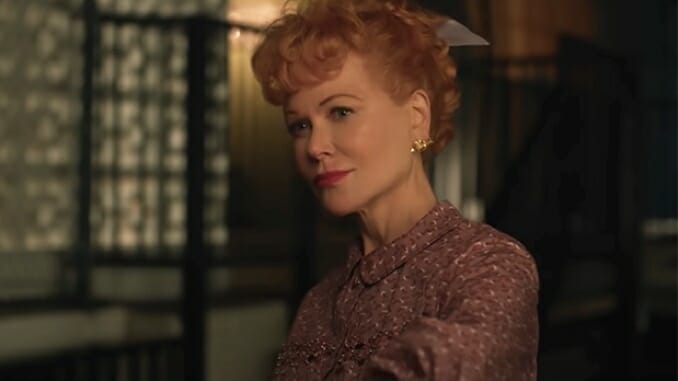Being the Ricardos Sags Under the Sorkin of It All

There’s a good movie baked into Being the Ricardos’ 131 minutes. It’s about 90 minutes long, maybe a little less. The remaining 41 minutes comprise an Aaron Sorkin movie, and like too much cream in a beautifully fried donut, they weigh down the total package with needless fat: Talking heads, flashbacks and archival footage. Lucille Ball’s story of perseverance, both in an industry that saw her as livestock to be herded rather than a professional to respect, and in a marriage held together by hot temperaments, hot sex and a collective drive to succeed, is an all-timer. Quite literally, the world that Being the Ricardos exists in wouldn’t without Ball and I Love Lucy. She’s a legend. She’s a pioneer. She’s shockingly good at pantomiming ineptitude. She’s Lucy!
But Sorkin has never met a culture-altering figure he couldn’t interpret as one of his home-grown characters. There’s a reason Lucille Ball registers as Lucille at all, and that reason is Nicole Kidman, cast as the great comedienne, businesswoman and trailblazer in spite of the howls of protest on Twitter. It may be commonplace these days to accept impersonation for performance at the expense of acting—we’re in a place where Ridley Scott hired Jared Leto and a mob of makeup artists to portray Paolo Gucci instead of just hiring Paul Giamatti—but Sorkin would seem to have no such delusions. Kidman may not be a 100% match for Ball in appearance, but boy does she commune with her spirit.
Watching Kidman become Ball is dazzling. Being the Ricardos is set during one week in 1952, when the House Un-American Activities Committee accused her of being a communist, right as her popularity, and the sitcom I Love Lucy’s popularity, were at a high: More people tuned in for the show than for Eisenhower’s inauguration and the Queen’s coronation. Desi Arnaz (Javier Bardem), Ball’s husband, co-star and the titular “I” of the show, wasn’t the only person who loved Lucy. America loved Lucy. (Arnaz happened to love women who weren’t Lucy, too.)
During Being the Ricardos, Sorkin backflips around the preceding decades to map out where they started out in their careers, how they met, how they took off as a success story and a Hollywood “it” couple, and how they arrived at the time and space where Sorkin has somewhat ambivalently set his film.
-

-

-

-

-

-

-

-

-

-

-

-

-

-

-

-

-

-

-

-

-

-

-

-

-

-

-

-

-

-

-

-

-

-

-

-

-

-

-

-








































